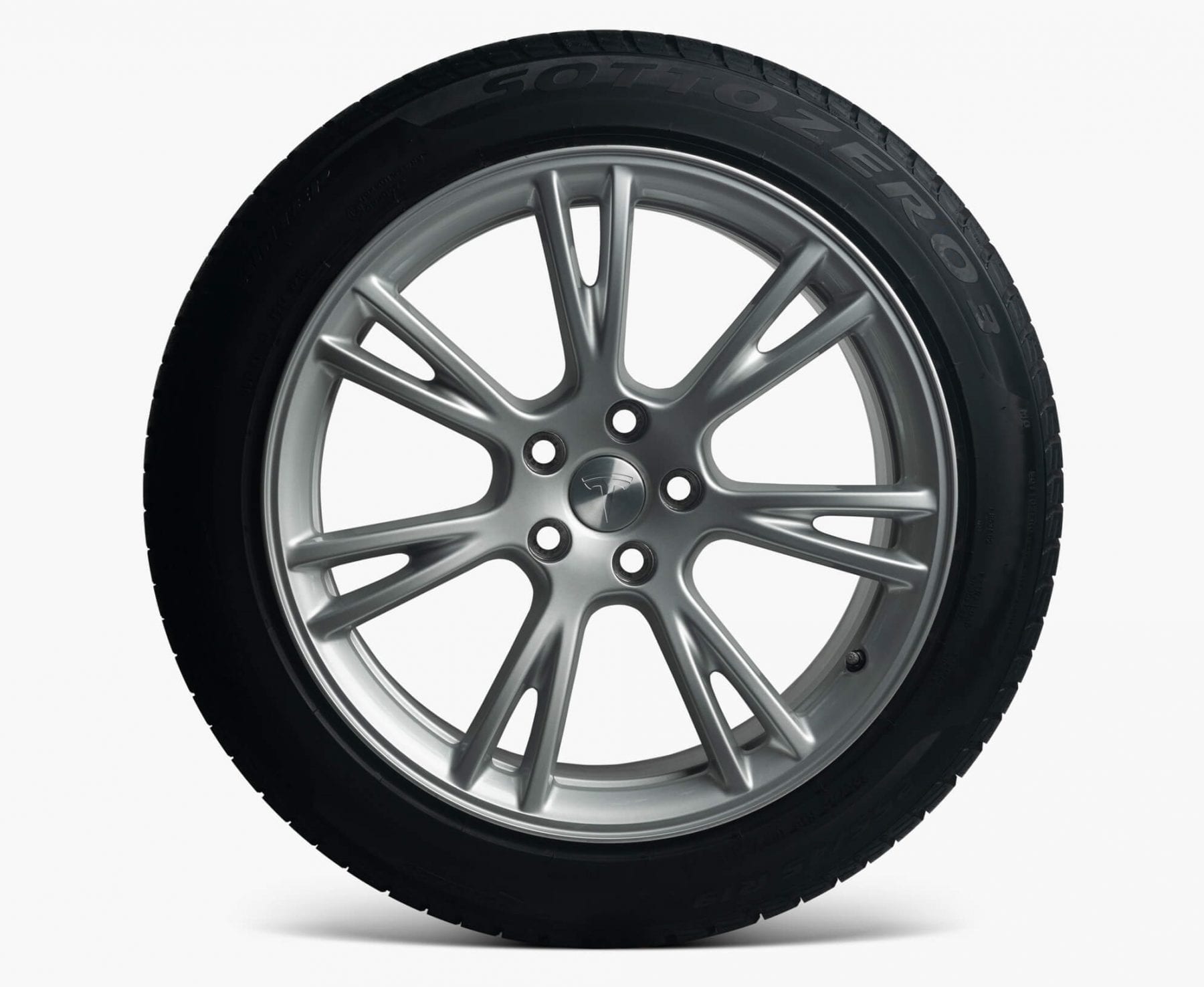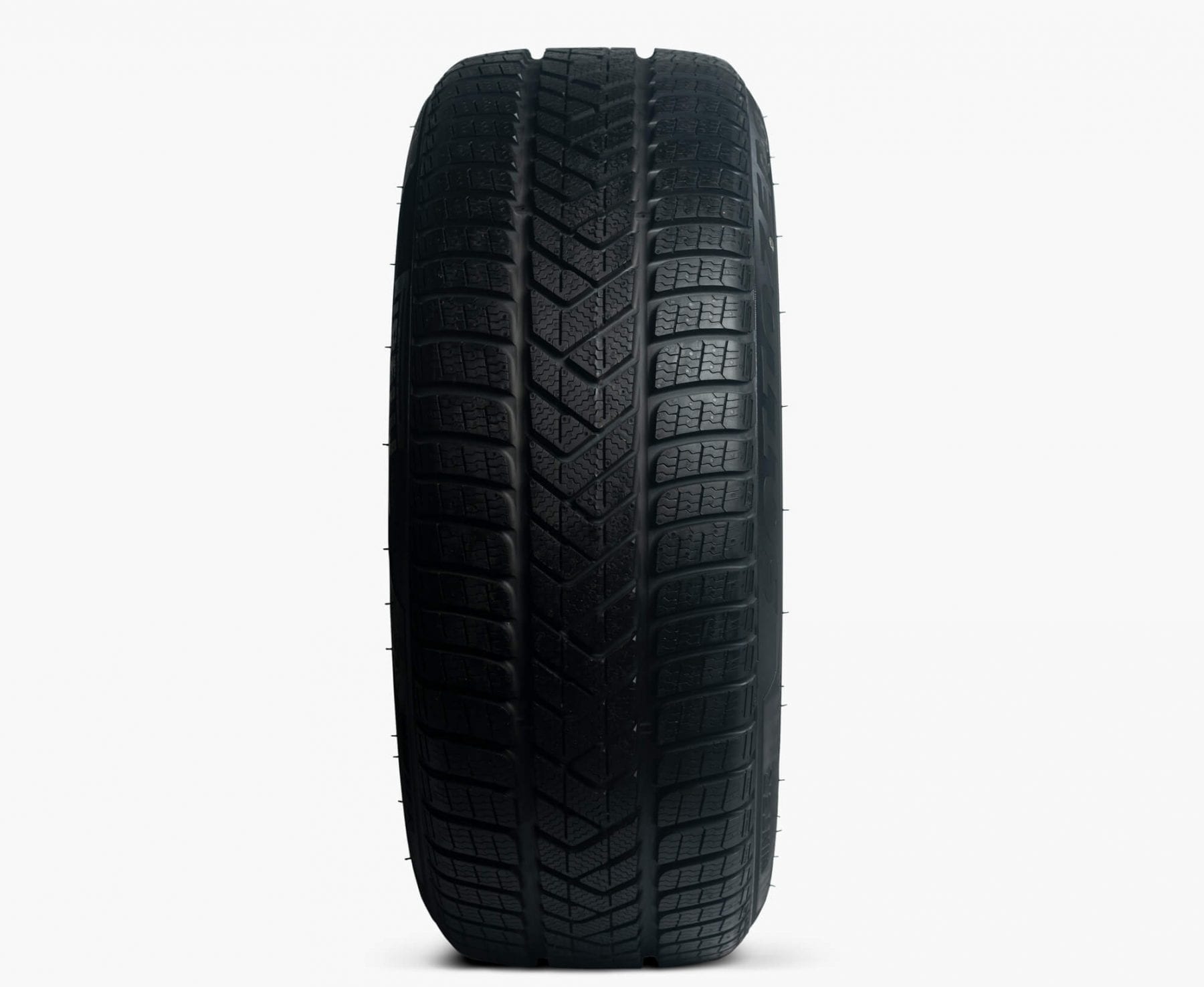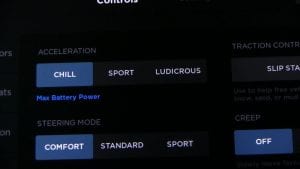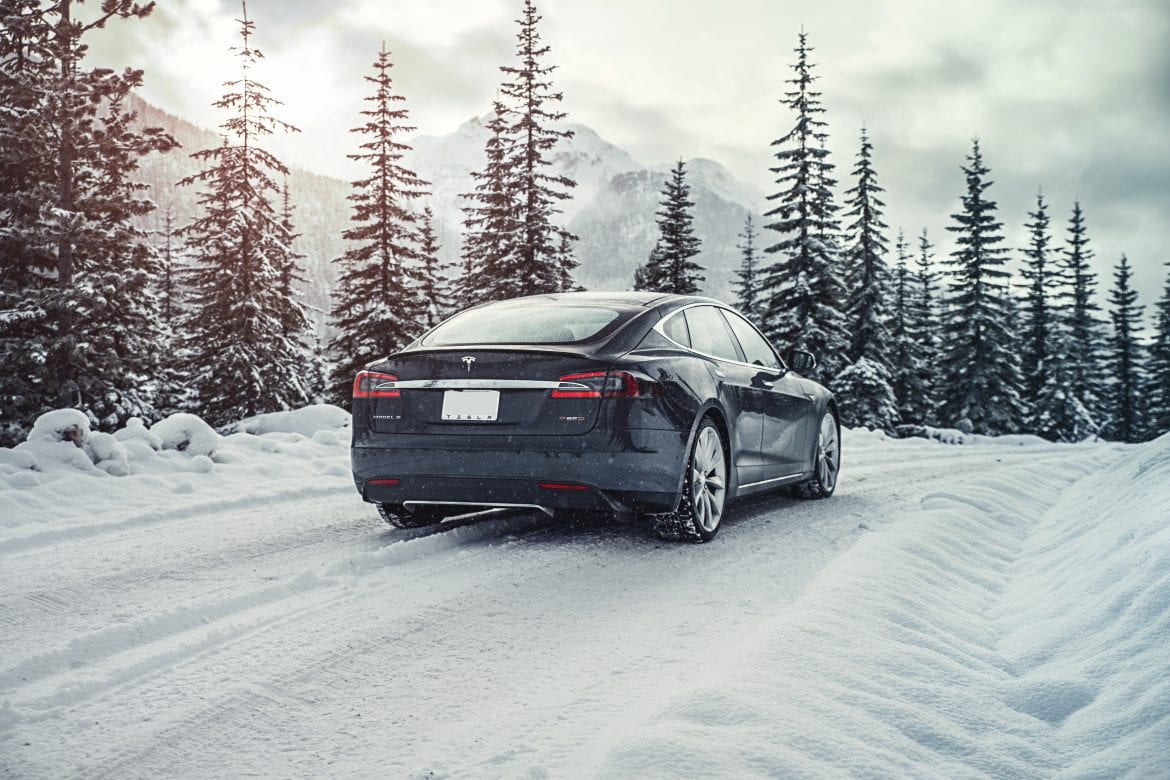Cold Weather Tips
[columns size=”1/2″ last=”false”]
- Use proper tires
- Prepare your wipers
- Disable auto-folding mirrors
- Plug in
[/columns]
[columns size=”1/2″ last=”true”]
- Precondition
- Disable Performance
- No Autopilot
- Defrost
[/columns]
Index |
|
|---|---|
|
|
|
|
|
|
|
|
|
With winter weather fast approaching it’s a good time to review some of the things you should watch out for when it comes to driving your Tesla in cold weather. Whether you have just recently moved to a colder climate, or just want to have a refresher of some best practices, here are some of our tips for dealing with snowy conditions in a Tesla.
Tesla Winter Range
Less of a tip and more of a fact of life that you will have to come to terms with. Whether you are driving an electric car or a gasoline-powered one, cold weather will lower the efficiency of your vehicle. Of course, with limited charging infrastructure and range being the most prominent statistic, you will most likely notice the drop off in efficiency more readily in an electric car. Tesla’s range in winter is no exception but there’s a few features and tips that can help you catch up.
The Tesla range in cold weather drop off will be especially noticeable if you take a lot of short trips. Since electric cars like to keep their batteries in their optimum operating temperature range, your Tesla will use a lot of energy to warm up its battery every time you get back in your car. If you can avoid taking short trips to avoid this constant warmup process then it will be for the better. That being said, if you can’t avoid it, your car should be far from useless. While there will be a notable drop in ranges, it should still be more than enough for your daily drives, especially if you charge overnight every day.
All EV’s are affected by cold weather range, whether they’re made by Tesla or not. Recently, a test was conducted to see how they all faired in comparison to their standard rated range.
Here are a few tips to maximize your Tesla’s range in the freezing temperatures:
[columns size=”1/2″ last=”false”]
- Setup Scheduled Departure
- Remain plugged in
- Defrost through the Tesla App
- Chill Mode
- Limit acceleration
[/columns]
[columns size=”1/2″ last=”true”]
- Use winter tires
- Use navigation (for automatic preconditioning)
- Don’t check app too often
- Use seat heaters instead of A/C
[/columns]
On the topic of charging at home, you should make complete use of the scheduled departure feature that was added via their Tesla software updates.
- Scheduled Departure: Tap ‘Charging’ > ‘Scheduled Departure’ > ‘Schedule’ > ‘Depart At.’
- Precondition: Open the Tesla app and tap ‘Climate’ > ‘Turn On.’
- Defrost: Open the Tesla app and select ‘Climate’ > defrost icon.
Not only will this allow your Tesla to charge during off-peak hours and lower your electricity bill, but it will also warm up both your battery and cabin by the time you plan to depart, saving your car from having to use its own energy to warm the battery. This one feature should make a big difference in your Tesla winter driving by eliminating some of that wasted energy and range.
Additionally, if you plan on Supercharging, make sure to set the Supercharger as your navigation destination. When a Tesla is directed to navigate towards a Supercharger, it automatically begins pre-heating your battery to allow for faster charging when you finally get there.
Regardless of whether or not you need the extra range, during the winter time you should leave your Tesla plugged in whenever possible. This will allow the car to use energy from outside of the battery to stay warm. Remember, a healthy battery is a happy battery. Not only will you minimize range loss and maximize performance, you’ll also keep your battery from rapid degradation.
Winter tires are probably the biggest thing that will help you out when driving in snowy and icy conditions. Having a set of Tesla winter tires can make all the difference between slipping and sliding on the roads and being fully in control. While winter tires won’t help your car win any performance on the road in dry summer conditions, it will allow you to run circles around anyone trying to get away with using summer tires or even all-season tires in cold enough climate.
Winter tires are made specifically to remain more pliable in colder temperatures, allowing them to be grippier than their non-winter counterparts. The deeper grooves in the tires allow them to handle snow and ice better and give you more consistent traction. Hydroplaning is limited thanks to increased drainage.
Of course, it’s not magic, if you happen to hit a big ice patch then your car might start doing some unintended maneuvers, so vigilant driving should always transpire during adverse weather.
Having a whole second set of tires might seem like a hassle and a big investment, but if you plan to live in an area with harsh winters long-term, then it’s an investment worth making from a safety standpoint. Plus you’ll be able to extend the life of your regular tires.
Options
Tesla has recently made it a tad easier for owners by offering sets of winter wheels and tires directly on their website. The sort-of Tesla winter package includes four rims wrapped in Pirelli Winter Sottozero tires along with some valve caps. For the Model Y Gemini winter wheels, the price comes in at $3,500. Buying a whole set of wheels comes with the convenience of being able to just take off your old wheels and place your winter-ready wheels. For those that don’t mind changing out the tires on their original rims every time winter comes around, you can get the same tires that Tesla offers for about $1,080, saving yourself almost $2,500.
 [/columns]
[/columns][columns size=”1/2″ last=”true”]
 [/columns]
[/columns]For those wanting a slightly more stylish option, Tesla also started offering sets with just about any of their rim choices. 20″ Induction wheels are available for the model Y with a $4,000 price tag. Though keep in mind, the larger the wheels, the more compromise you must make on range.

Regardless of which you choose, Tesla winter driving is both safer and easier with a set of Tesla winter wheels. Tesla snow chains are also available on their website for those who want to drive the extra mile in non ideal conditions.
As is normal with all cars, defrosting is a big part of winter driving. Tesla adds their twist of quirks making certain aspects just that much easier.
Wipers
In general practice, if you are expecting an extremely cold night, then it is a good idea to move your wipers from their default resting position entirely away from the windshield, or at least in a position where heat from the cabin could melt and ice that might have caused your wipers to freeze to the windshield.
To be able to raise your wipers, Tesla has an option to put your wipers in ‘service mode’ which will bring them to the middle of the windshield. You can find the button in:
‘Controls’ > ‘Service’ > ‘Wiper Service Mode’ > ‘On’
Keep in mind that this will not allow you to lift the wipers to stop contact with your windshield. However, owners have suggested placing small objects at the base of the wipers to wedge them and have the wipers lift off the surface just slightly. Regardless, in this position, any heat from your cabin should make contact with the windshield and melt any ice that binds your wipers.
Windshield Wiper Fluid
This might seem like a simple one, but you are going to feel absolutely silly when your windshield wiper fluid freezes. Below freezing conditions are not the time for some redneck engineering. Skip the water and make sure that your wiper fluid is designed to not freeze in your expected low temperatures. Take a step further and consider fluid formulations that come with de-icers to help with clearing any ice that might obstruct your vision.
Mirrors
If you are someone who likes to have their mirrors auto-fold, it may be in your interest to turn off the auto-fold feature during cold weather. In below freezing temperatures, it is possible for your mirrors to be frozen in their closed position. With them constantly trying their best to break free, it’s possible to burn out the motors. To find the option to turn of auto-folding mirrors you can go to:
Model S/X: ‘Controls’ > ‘Vehicle’ > ‘Mirror Auto-Fold’
Model 3/Y: ‘Controls’ > ‘Quick Controls’ > ‘Mirrors’ > ‘Mirror Auto Fold’
If your mirrors happen to freeze shut, Tesla recommends manually opening and closing them to break the ice.
Cabin
To warm the car up Tesla has implemented a defrost feature to the Tesla App. With it you can begin to defrost your windows prior to stepping outside. Tesla’s cars also come suited with heated seats for optimal comfort. The Model S/X have the addition of heated steering which is currently rumored to come to the Model 3/Y.
The defrost feature is recommended by Tesla to use prior to charging. With extreme conditions, the charge port can freeze over allowing for a slower charge rate. The car will indicate a frozen charge port with a blinking amber light. With the new-age of electrification and the company being technologically advanced above the rest, there are few more things to consider when using your Tesla in snow.
If you are someone who has fully embraced one-pedal driving, then you might have to adapt during Tesla winter driving. You might want to consider setting your regenerative brake strength to the lowest available. This is done simply for safety reasons. The strong regenerative braking could potentially be too aggressive in icy conditions and might cause your Tesla to lose traction and slide. It obviously will be down to your individual weather conditions, but it should be something you are cognizant of.
Regardless, the cold weather might force you to use your brake pedal whether you like it or not. If you are driving around with a cold Tesla battery in cold weather then it won’t accept energy from the regeneration system and as such, you will have to brake on your own. Thankfully your Tesla should inform you on whether or not your braking has been reduced or not, allowing you to prepare. A blue snowflake icon next to your range will display when both your regenerative braking and power is decreased. Once the battery gets back up to temperature the full strength of the regenerative braking and power should return.
While on the topic of safety, it’s probably best to disable performance mode. Tesla performance in cold weather is already affected negatively and there’s no reason to go drag racing against sleds.

You are not going to do any speed runs on icy roads, at least not safely. It is recommended that you switch your power delivery to chill mode to limit the amount of instant power that is delivered to the wheels, lessening the risk of the tires losing traction. The switch to a lower power level should also help with countering the range loss in cold weather.
Anyone who has lived through one season of winter weather can attest to how absolutely filthy everything gets, including your car. With that being the case you should make sure to check on your Autopilot cameras and clean them off if they are covered in dirty ice. Your Tesla should recognize that its cameras are obstructed and restrict any Autopilot features, but it still is good practice to do a quick walk around, especially if you park outside.
Autopilot however should be limited during harsh conditions. With strong snowfall cameras have minimal vision and if the roads are covered in snow, lane markings are impossible to recognize. The cameras however should remain clear for emergency situations in which your Tesla can prevent an accident on its own.
Most Teslas today are built all-wheel drive with the exception of the Standard Range Model 3. However, if you’ve owned your Tesla for a few years, you should take not of whether your car is all-wheel drive or rear-wheel drive as this too will have an effect when driving in winter conditions. While it is by no means impossible to drive a RWD Tesla in the snow, the process is easier when you have all four wheels putting in work.
One of the major benefits of an all-wheel drive system is that the car can torque vector, to an extent. In a Tesla, this allows more control over driving conditions with the car automatically focusing its braking power to the wheels with more traction. With the Model 3’s Track Mode, torque vectoring becomes more advanced, but we highly discourage using Track Mode in the snow.
Once again, it is not impossible to drive a Tesla RWD in snow, but if both of your rear wheels end up in a situation with no traction, then you will be stuck. Simply put, four vs two wheels increase the likelihood of not losing traction.
Tesla rear wheel drive cars do actually work well on snow & ice. We did our traction testing on an ice lake! Dual motor AWD is great, but not required for cold weather. Just don’t use sport/summer tires.
— Elon Musk (@elonmusk) October 18, 2018
Of course winter conditions vary throughout the world with some being harsher than others. Not everyone will have to prepare for Mount Everest like conditions. When the Tesla Model 3 first hit the streets, its first winter brought some unexpected issues. Since then both quality and durability have drastically improved. Through software alone the company has been able to drastically increase its Tesla cold weather range. EV’s aren’t necessarily the best in cold weather but Tesla has proven the burden can be minimized.
Through software and a neural net, a lot of these minor inconveniences can eventually be automated. Maybe the company will one day offer a Tesla cold weather package to make snowy ownership that much easier. Only time will tell and with other projects in focus, we are still many years away from a Tesla snowmobile.
[mv_create key=”6″ type=”diy” title=”Tesla Winter Tips and Tricks” thumbnail=”false”].

1 comment
You may also want to add getting a compatible, high-quality winter tire to the equation. Not only would it be safer to drive during the snowy weather, but it would also ensure a smooth ride overall. 4WheelOnline sells a couple of them, so be sure to check them out.